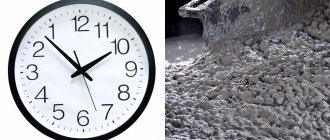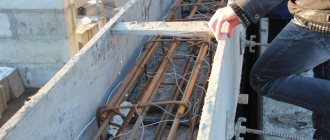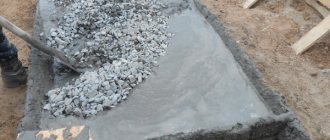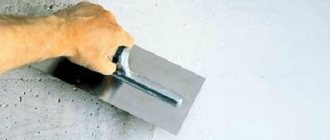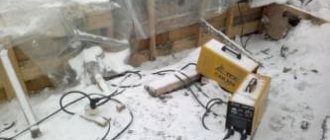Hardening of concrete after pouring is an inevitable process. The quality of the poured concrete product directly depends on the activities carried out at the time of concrete hardening.
After laying and starting to set, the concrete is allowed to stand in conditions that provide the required strength and quality.
Hardening of concrete is a complex physical and chemical process of interaction between water and cement, which will result in the formation of new compounds. The penetration of water into cement particles occurs gradually, which is the reason for the long development of strength.
A humid environment is of great importance in gaining strength. Concrete that hardens in wet conditions is much stronger than concrete that hardens in dry conditions. In a dry environment, water quickly evaporates from concrete and its hardening slows down or stops completely. In this regard, premature drying of concrete before achieving the required strength should not be allowed.
Shrinkage of concrete
During the curing period, the water in the middle of the concrete moves and evaporates into the external environment, resulting in a decrease in volume, that is, shrinkage. This process does not occur evenly, and small shrinkage cracks appear. Crack formation also occurs from uneven heating of concrete due to the release of heat during the process of cement hydration. In turn, cracks significantly affect the quality, durability and strength of structures.
The intensity of concrete hardening is also affected by its temperature. At temperatures below normal (20 + 2 degrees), the process slows down, and at negative temperatures it practically stops. As the temperature rises and there is sufficient humidity, hardening accelerates.
Concrete hardening conditions and care
Hardening of concrete is a complex physical and chemical phenomenon in which cement, interacting with water, forms new compounds.
Water penetrates deep into the cement particles gradually, as a result, more and more of its portions enter into a chemical reaction. Therefore, concrete hardens gradually. Even after several months of hardening, the inner part of the cement grains still does not have time to react with water.
Under favorable hardening conditions, the strength of concrete continuously increases. For normal hardening of concrete, a positive temperature of 20 (±2) ° C is required with a relative humidity of at least 90%, created in a special chamber or by filling the concrete with constantly moistened sand or sawdust.
Under normal hardening conditions, the increase in concrete strength occurs quite quickly and concrete (Portland cement) gains 60-70% of its 28-day strength 7-14 days after production. Then the growth of strength slows down.
If concrete hardens all the time in water, then its strength will be higher than when hardening in air. When concrete hardens in a dry environment, the water from it will evaporate after a few months and then hardening will practically stop. This is explained by the fact that the inner part of many cement grains does not have time to react with water. Therefore, in order for concrete to achieve the required strength, it should not be allowed to dry out prematurely. In warm, dry and windy weather, corners, edges and exposed surfaces of concrete dry out faster than the interior. It is necessary to protect these elements from drying out and give them the opportunity to achieve the specified strength.
When concrete hardens, its volume always changes. As concrete hardens, it shrinks, which occurs faster in the surface zones than inside, therefore, if there is insufficient moisture in the concrete during the hardening period, small shrinkage cracks appear on its surface. In addition, cracking is possible as a result of uneven heating of massive concrete due to heat generation during setting and hardening of cement. Cracks reduce the quality, strength and durability of concrete.
The increase in concrete strength largely depends on the temperature at which hardening occurs. The hardening of concrete at temperatures below normal slows down, and at temperatures below 0°C it practically stops; on the contrary, at elevated temperatures and sufficient humidity, the hardening process accelerates.
The duration of hardening is of great practical importance in concrete work. Acceleration of hardening is necessary when rapid loading of the structure with operational load or early stripping is required, and mainly during work in winter and in the manufacture of concrete and reinforced concrete products.
To accelerate the hardening of concrete, accelerator additives are used (calcium chloride, sodium chloride, calcium nitrate, potash, alumina sulfate, ferric chloride, building gypsum), introduced during the preparation of the concrete mixture. The percentage of additives is established experimentally or taken in accordance with the instructions of special instructions.
The addition of chloride salts (calcium chloride, sodium chloride or ferric chloride) is allowed to the concrete of unreinforced structures no more than 3% of the weight of cement, to the concrete of reinforced structures - no more than 2%. You can also read more about this topic in the section Concrete with antifreeze additives.
Accelerator additives are not allowed to be added to concrete mixtures intended for the production of:
- prestressed reinforced concrete products and structures with wire reinforcement with a diameter of 5 mm or less;
- reinforced concrete structures intended for operation at a relative air humidity of more than 60%, as well as insulation for roofing in the case of the use of chloride salts;
- structures on the surface of which the formation of efflorescence cannot be allowed if experimental testing has established their occurrence;
- autoclaved products;
- concrete and reinforced concrete structures that are erected in areas of stray currents.
Accelerator additives are prohibited from being introduced into concrete mixtures prepared using aluminous cements.
In the production of prefabricated reinforced concrete, and in the cold season for monolithic concrete, heating of concrete with steam or electric current is widely used to accelerate hardening.
Sometimes during emergency restoration work, expensive aluminous cement is used, which after a day of hardening gives 80-90% of the 28-day strength.
The hardening process is accelerated by especially fast-hardening Portland cement (OBTC) and rapid-hardening Portland cement (BTC), as well as rigid concrete mixtures.
In order for freshly laid concrete to receive the required strength at the appointed time, it needs proper care: keeping it moist, protecting it from shocks, damage, impacts, as well as sudden temperature changes.
Lack of maintenance can lead to low-quality, defective and unusable concrete, and sometimes to the destruction of the structure despite the good quality of the materials used, the correctly selected concrete composition and careful concreting. Caring for concrete during the first days after laying is especially important. Inadequate maintenance in the first days can degrade the quality of the concrete to such an extent that it is practically impossible to correct it even with careful maintenance in subsequent days.
Favorable temperature and humidity conditions for concrete hardening are ensured by protecting it from the harmful effects of wind and direct sunlight and by systematic watering. To do this, the exposed surfaces of freshly laid concrete are covered with a moisture-absorbing coating (burlap, a layer of sand, sawdust, etc.). Depending on climatic conditions, the frequency of watering of the moisture-absorbing coating should be such that the surface of the concrete is always wet during the maintenance period. In dry weather, exposed surfaces are kept damp until the concrete reaches 70% of its design strength.
Water the concrete using fire nozzles with tips that spray a stream.
In hot weather, wooden formwork is also watered. When removing formwork before the expiration of the watering period (for example, formwork of columns, walls, side panels of beams), the stripped vertical surfaces of concrete structures are also watered. It is most effective to water vertical and steeply inclined surfaces with a continuous flow of water through a system of tubes with small holes. In hot, dry climates, this method of watering is mandatory.
Freshly laid concrete in contact with flowing groundwater (especially aggressive) must be protected from their influence by temporary water drainage, insulation and other means for 3 days if it is made with aluminous cement, and 14 days if made with other cements.
Covering and watering concrete requires a significant amount of labor, so surfaces that are not intended for future monolithic contact with concrete and mortar (for example, platforms, roads, airfield pavements, floors, ceilings), as well as shotcrete layers, can be coated with special paints instead of covering and watering compositions and protective films (ethinol varnish, tar and bitumen emulsions, liquefied bitumen, polymer films).
Enclosing structures made of lightweight concrete on porous aggregates, the moisture content of which has special requirements, are not watered, but covered with a painting composition and films that protect the concrete from moisture.
The movement of people on concrete structures, as well as the installation of scaffolding and formwork on them, is allowed only when the concrete reaches a strength of 15 kg/cm2. The movement of vehicles and concrete-laying machines on a concreted structure is allowed only when the concrete reaches the strength specified in the work design.
The composition of concrete care measures, the order and timing of their implementation are established by the construction laboratory and approved by the technical management of construction.
Methods for regulating the temperature regime in concrete of massive structures from the beginning of laying the concrete mixture until the moment of grouting of interblock joints and concrete cooling modes are established in the construction project or in the work execution project.
Concrete maintenance activities are recorded in the Concrete Work Log.
- Concrete science
- Manufacturing technology of prefabricated reinforced concrete structures and parts
- General issues in precast concrete production
- Preparation of concrete mixtures
- Production of mortar mixtures
- Transporting concrete mixture
- Preparation of reinforcement
- Formwork
- Preparing molds, forming concrete and curing products Preparation of molds
- Product molding
- Accelerating concrete hardening
- Concrete care Stripping structures
- Correction of concreting defects
- Safety precautions
- Finishing of concrete surfaces
- Stripping, warehousing and storage of finished products
- Quality control
- Reinforcement and forming of prestressed products
- Features of the production of various types of concrete and reinforced concrete products
- Concreting of various structures
- Concrete work in winter conditions
- Production of prefabricated structures and parts from lightweight concrete
- Production of prefabricated products from dense silicate concrete and concrete with clinker-free binder
- Production of concrete and reinforced concrete products at landfills
- General safety rules and fire prevention measures at a construction site
Factors negatively affecting concrete hardening
Shocks and vibrations in the initial period of its hardening also lead to deterioration in the quality of the structure - they disrupt the newly created structure.
In order for concrete to gain the required quality and strength, it needs proper care. It is necessary to maintain the hardening temperature regime, prevent the occurrence of temperature-shrinkage deformations and cracks, and protect the hardening structure from mechanical influences.
Failure to comply with concrete hardening conditions can lead to a low-quality structure and sometimes to its destruction. This can also happen if high-quality concrete is laid and all concrete, reinforcement and formwork work is carried out correctly. It is especially important to care for hardening concrete during the first days after laying.
How can you influence the setting speed?
The setting speed affects the quality of the concrete mixture. Any deviation from the standards negatively affects strength and durability.
How to slow down the setting of concrete
It is necessary to delay setting in the following cases:
- When pouring concrete in hot weather.
- When transporting concrete mixture over long distances.
- When there is difficult, heavy traffic on the roads, when the concrete mixer truck has to stand in traffic jams for a long time.
- When pouring concrete in stages, so that the mixture remains in its original state for a long time.
With the help of retarders, it is possible to postpone the chemical reaction between cement grains and water for several hours, from 48 to 72. At the same time, the properties of the concrete mixture are preserved, including strength and durability. The following concrete retarders are used:
- Linamix;
- Polyplast Retard;
- Sika Retarder.
How to speed up the setting of concrete
When carrying out construction work in winter and when manufacturing reinforced concrete products, the setting time of the concrete mixture is artificially reduced with the help of special additives. Concrete setting accelerators are added to the composition in the required proportion. It is not allowed to exceed the limit level, which is established experimentally in construction laboratories.
The following substances are used:
- Sodium sulfate. The application limit is 2%. This accelerator is used in the production of concrete mixtures and reinforced concrete structures.
- Salt of nitric acid. The upper limit is 4%.
- Calcium chloride. The maximum permissible level is 3%.
If the use of accelerators is combined with autoclaving, the setting time will be further reduced. Slabs and other reinforced concrete products are placed in an autoclave-steam room, where they are steamed under high pressure.
To ensure that the concrete mixture is guaranteed to set in winter, it is prepared from preheated materials and then heated with electric current and steam. During the preparation process, the mixture is heated to 800C, after which it is covered with insulation so that the heat is retained for 2-5 days.
Recommendations for caring for freshly poured concrete
To prevent the appearance of cracks, cover the concrete and water it no later than 10-12 hours later, and during windy weather or heat, 2-3 hours after laying (these standards do not apply to the care of concrete in hot, dry climates and in winter). In the summer, in a temperate climate zone, in dry, warm weather, concrete based on ordinary Portland cement is watered for 7 days, with alumina cement - 3 days, and with slag Portland cement for 14 days. If the air temperature is more than 15 degrees in the first three days, the concrete is watered every three hours during the day, and once at night. Further, watering is carried out at least three times a day. If the surface of a concrete structure is first covered with a material that retains moisture, such as a tarpaulin or mats, the intervals between watering can be increased by 1.5 times. Concrete, the surface of which is covered with a protective polyethylene film, is not watered, and watering is not carried out at air temperatures from +5 to 0 degrees.
Concrete polymerization is a complex two-step operation
Hardening of the concrete mixture occurs through a chemical process called hydration. This reaction is understood as the transformation of the initial elements of the building composition (cement, crushed stone, sand, water, other additives) into calcium hydrosilicate.
After complete completion of the process, a monolithic composition with high strength properties is obtained. The hardening time of concrete depends on:
- brand of cement used;
- mixture composition;
- atmospheric humidity;
- compliance with concrete working technology;
- air temperature (in the room where the described mixture is used, and outside);
- thickness and density of laying the concrete layer;
- care of the structure during its hardening.
Complete polymerization of the concrete mixture takes place in two stages - setting and gaining design strength. These stages have their own characteristics that should be taken into account when performing construction work.
How to cover concrete
The most common method of covering concrete is the use of materials that retain moisture, mats, matting, and sand. But in most cases, transferring these materials and keeping them wet is a labor-intensive process and is not suitable for large volumes of concreting. It is considered more effective to use waterproof films, for example polyethylene, and also in accordance with the operational requirements of film-forming materials, preferably light colors. To provide such protection, standard film-forming materials (FM), as well as ethinol varnish and bitumen emulsions, are used. Films are dark in color, after their formation it is better to lighten them; this can be done with aqueous solutions of chalk. In summer, concrete is protected from sunlight, and in winter from frost.
To prevent harmful loads on concrete, the movement of people on it, the installation of leveling or formwork is allowed only after achieving a strength of at least 1.5 MPa.
What determines the hardening time of the solution?
The strength of concrete is greatly influenced by the grade of cement from which it is made. The most reliable mixtures are made from M500 material. And the weakest ones are made from M100 cement.
| Brand | Strength, kgf/sq. cm |
| M500 | 524 |
| M450 | 458 |
| M400 | 393 |
| M300 | 327–360 |
| M250 | 262 |
| M200 | 196 |
| M150 | 131–164 |
| M100 | 98 |
The presence of different components in concrete changes its hardening time. The more gravel or sand in the mixture, the faster the water comes out of it. With an increased content of slag and expanded clay, the liquid evaporates more slowly from the solution. The table shows the recommended ratios of the main components of concrete mixtures.
| Brand | Consumption per 1 cubic meter | Water cement ratio | |||
| Water, l | Cement, kg | Crushed stone, kg | Sand-gravel mixture, kg | ||
| M400 | 205 | 492 | 1000 | 661 | 0,41 |
| M300 | 205 | 384 | 1055 | 698 | 0,55 |
| M200 | 185 | 287 | 1135 | 751 | 0,64 |
| M100 | 185 | 206 | 1177 | 780 | 0,89 |
The strength of concrete decreases if the required density of its placement is not maintained. Important! The liquid leaves the mixture the slower, the greater the density of the solution. During industrial construction, concrete is processed with special vibration equipment. In everyday life, it is replaced by the operations of bayoneting with a shovel and compaction with a manual tamper.
To retain moisture in the concrete mixture placed in the formwork structure, it is recommended to cover the latter with a waterproofing agent. As such, bitumen mastic or ordinary polyethylene film is used. These materials enhance hydration as they prevent rapid dehydration of concrete.
A similar effect is achieved by periodically wetting the hardening solution with water. The liquid is applied by spraying or spraying. Note! These measures do not speed up the concrete hardening process.
Daily schedule
The daily schedule for obtaining the factory strength of concrete indicates the time interval during which the mixture acquires factory properties. In a favorable environment, the composition has time to “mature” in 28 days, while the greatest effectiveness of hardening is noticed during the first 5 days. A week after pouring, the strength indicator reaches 70%. In this case, it is allowed to begin further work only after receiving 100% of the value, i.e. after 28 days.
However, as environmental conditions change, the graph readings may change. To accurately determine how long it will take for concrete to completely harden, control tests of samples should be performed.
During the warm season, the process is optimized using 2 methods:
- Curing of concrete in formwork.
- Maturing of the mixture after dismantling the formwork structure.
If work is carried out during the cold period, the structure must be additionally heated and protected with waterproofing materials. Otherwise, the polymerization process will be slowed down.
| Concrete grade M200-M300 (the solution was created on the basis of Portland cement M400-M500) | Average daily temperature at which concrete hardens, °C | Curing interval | ||||||||
| 1 | 2 | 3 | 5 | 7 | 14 | |||||
| Compressive strength of concrete (% of factory value) | ||||||||||
| -3 | 3 | 6 | 8 | 12 | 15 | 20 | ||||
| 0 | 5 | 12 | 18 | 28 | 35 | 50 | ||||
| +5 | 9 | 19 | 27 | 38 | 48 | 62 | ||||
| +10 | 12 | 25 | 37 | 50 | 58 | 72 | ||||
| +20 | 23 | 40 | 50 | 65 | 75 | 90 | ||||
To speed up the process and reduce the holding time, you should use sand concrete with a minimum ratio of water to cement. If the proportions of water and cement are ¼, the schedule time will be reduced by 2 times. To get a positive result, the composition can be diluted with plasticizers.
Functions of magazines in construction
Logs are a type of executive documentation, with the help of which the current state of affairs at a construction site, comments from regulatory authorities are monitored, the responsibilities of engineering and technical personnel are clearly stated, deviations from the schedule are recorded, and the like. Types of logs vary depending on the objects and work performed.
The importance of maintaining such documentation is difficult to overestimate. The quality of the material after hardening cannot be checked in any other way except by reading the relevant documentation without destroying the structure. Concrete work is a critical stage of construction. If during the process of pouring concrete there were violations of building codes and regulations, this can lead to negative consequences.
Hardening process
After cement and water are mixed to produce a solution, a complex interaction begins between them, as a result of which a completely new compound is formed with its own characteristics. Water gradually penetrates into the cement grains, the minerals of which enter into a chemical reaction with it. During this reaction, minerals are converted into potassium hydrosilicates. This process is called concrete hardening.
The degree of concrete hardening can be checked using specialized diagnostic tools.
Hardening is not completed in one day. In order for concrete to gain the strength it needs and cease to be plastic, a certain period of time is required. This is called the hardening time. Hardening can last for years, which can significantly extend the construction process for a very long time. Builders cannot wait that long, and they have calculated a target setting period after which the foundation can withstand the design load.

